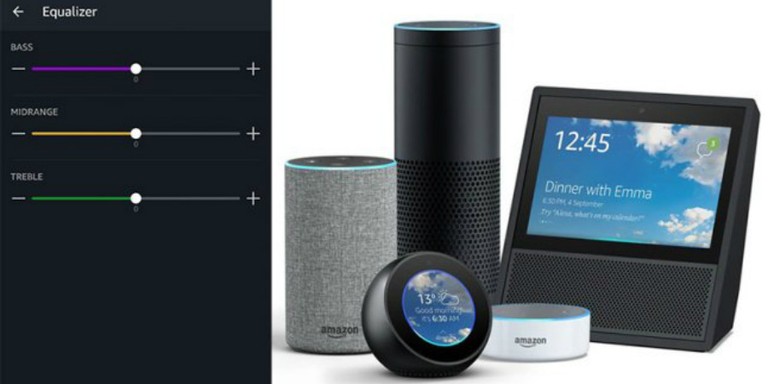Amazon’s Echo Devices Gain Voice-Controlled Audio Equalizer Settings
Unless your musical diet is composed entirely of the audiophile-approved recordings that haunt the halls of every audio show, chances are good that some of your favorite tunes just don’t sound that great. This is certainly the case for me. I love early Beatles records, but the low-end is undeniably scrawny. In Please Please Me, Paul’s bass and Ringo’s drums are lacking both the punch and the body that make them so satisfying in Abbey Road. I am also big fan of singer-songwriter Rufus Wainwright, whose songs often include dense and complex orchestrations. But on his 2003 album Want One, the treble becomes harsh during loud passages, and I always have to reach for the volume knob. The same goes for Imogen Heap, whose electronic wizardry has yielded some of the most interesting pop music of the 21st century. There can be a fine line between clear highs and piercing ones, and her 2005 album Speak for Yourself crosses that line more than once. If your playback gear has tone control knobs or a multi-band equalizer, you can of course tweak the sound to your liking. But these days, many people are listening to music on ultra-simple smart speakers, most of which offer no way to make adjustments to the sound. Is there a demand for more control over sound quality in the context of casual listening? Amazon believes that there is, and the company has recently announced new equalizer and sound mode controls for its Echo-branded smart home entertainment devices. Echo users will now be able adjust the bass, mid-range, and treble of their smart speakers with simple voice commands.
With the new voice commands, you can ask Alexa to increase or decrease the level of bass, midrange, or treble by as much as 6 dB in either direction. For example, you can say, “Alexa, set the treble to plus 1,” or “Alexa, turn up the bass to maximum.” Less specific commands also work, if you don’t know the exact setting you’re shooting for. You can say, “Alexa increase the midrange,” or “Alexa, turn down the treble.” The adjusted settings will apply to all content, including podcasts, videos, and audiobooks, until you make another change. If at any time you want to revert back to the default settings, just say, “Alexa, reset equalizer.” So far, the voice commands are only working with English-speakers in the United States, but the equalizer settings can also be accessed via the Alexa app for mobile devices. Simply select the Echo device that you want to adjust under the “Alexa devices” option, and tap the “sounds” tab.
The new equalizer controls work with the first-generation and second-generation Amazon Echo and Amazon Echo Dot. They also work with the Echo Plus, the Echo Show, and the Echo Spot. Users of the Echo Show and Echo Spot will also be able to make adjustments via those devices’ built-in touchscreens. Of course, audiophiles know that none of these devices is really capable of great sound, no matter how much tweaking you do. Luckily, Amazon has made the new equalizer controls available to third-party audio companies, such as Sonos and Polk, that use Alexa's open software tools to give their own better-sounding products the benefits of a smart interface. According to Amazon, the new controls will work with “select Alexa-enabled devices built using the Alexa Voice Service … (including) speakers, AV receivers, and sound-bars.” Not only will users of these devices be able to make individual adjustments to the audio bands as described above, but they will also have the option of choosing from several pre-set equalizer modes, such as Movie, Music, Night, Sport, and TV. In fact, these modes have already been incorporated into the new $399 Sonos Beam sound-bar. Not to be outdone, Polk has implemented all of the new equalizer controls in the $299 Polk Command Bar. It remains to be seen whether users of Amazon’s mediocre-sounding smart speakers will take advantage of these new audiophile features, but easy equalizer controls will certainly be a welcome addition to many of the third-party products that combine Alexa’s smarts with high-performance audio.
Does Alexa’s ability to make adjustments to your music’s tonal balance give Amazon’s voice assistant an edge over the competition from Google and Apple? Share your thoughts in the related forum thread below.


